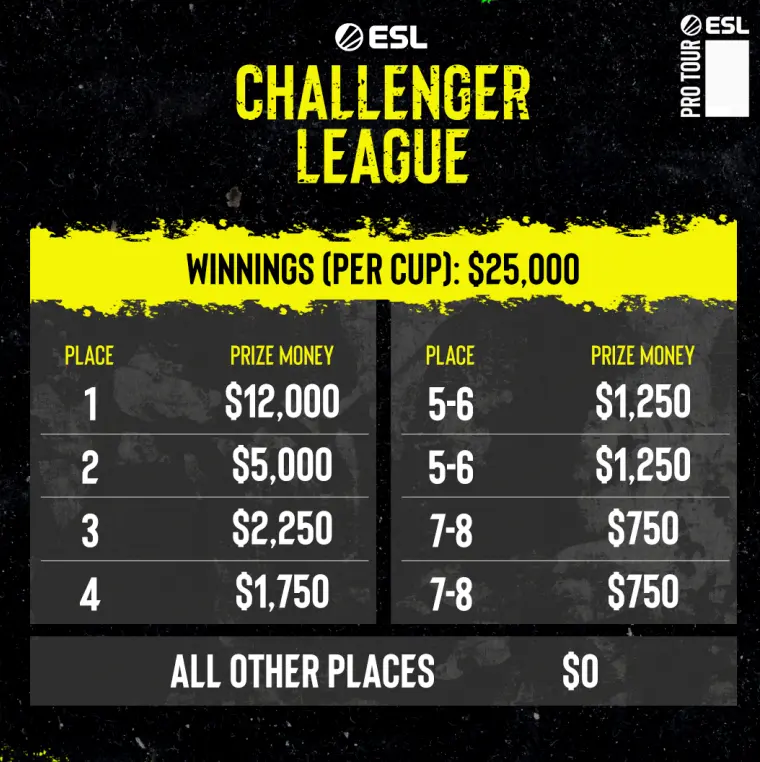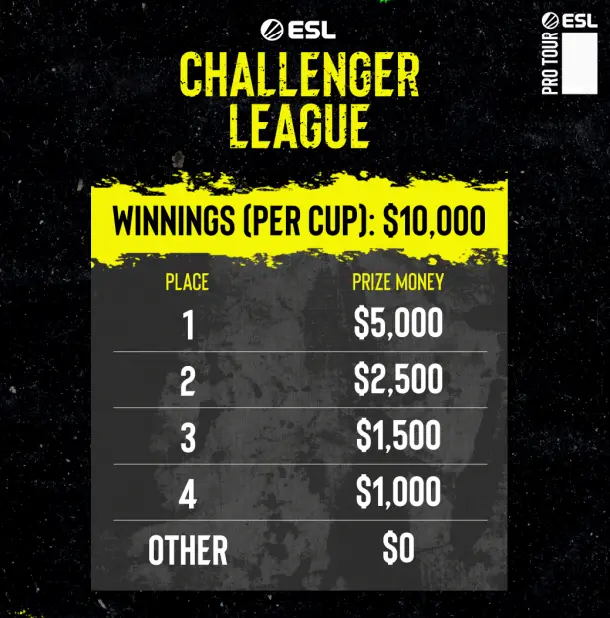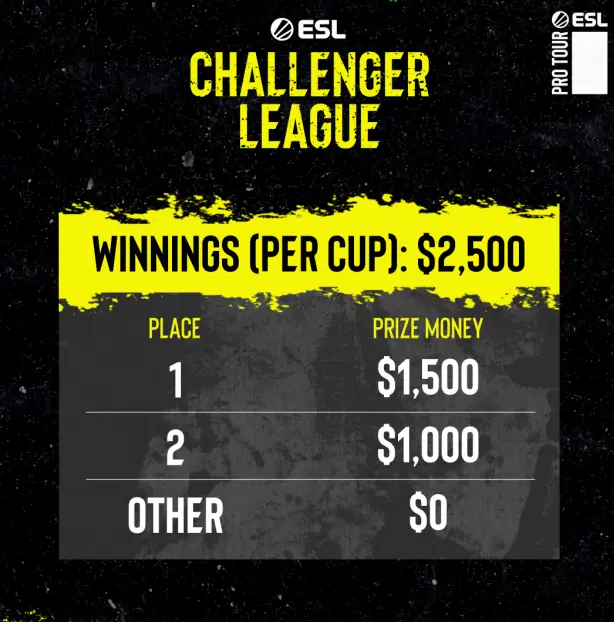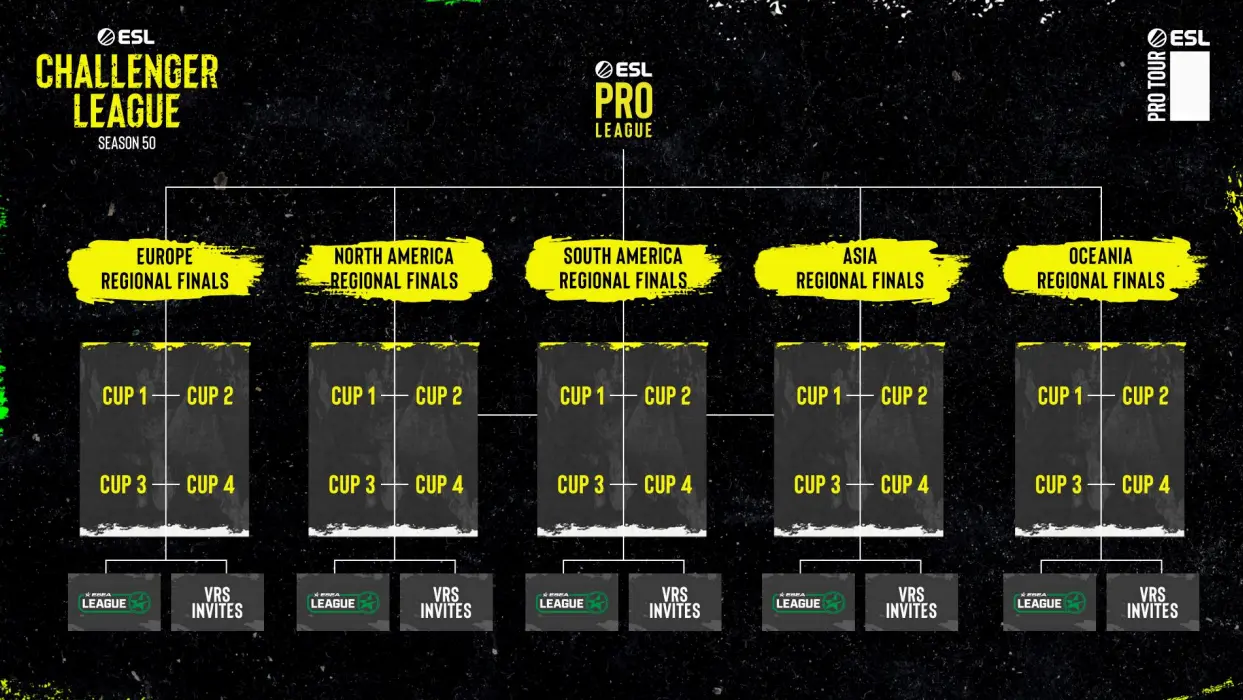
ESL has introduced an updated structure for the Challenger League. Instead of the classic league format, each region will now host four cup stages, after which the best teams will compete in regional finals. The new system is more flexible, competitive, and aligns with Valve's current tournament requirements.
Reasons for the Changes
The changes are prompted by Valve's new requirements for organizing competitions within the VRS (Valve Regional Standings). The old seasonal league format no longer met these requirements. In addition to aligning with VRS, the new format allows for:
- Eliminating best-of-1 matches — now only best-of-3
- Reducing match overload for teams
- Simplifying the path to the ESL Pro League
- Making tournament participation accessible to the tier-2 scene
Format for Europe
Each of the four cup stages in the European region is classified as a tier-2 tournament. This means that its results will be considered in the VRS, which forms the basis for invites. The format is Double Elimination with best-of-three matches. The winner of each stage earns the right to participate in the European regional finals.
If a team wins two cups, they advance directly to the grand final of the regional finals. Winning three cups cancels the semifinals, and the team starts the grand final with a one-map advantage. Winning all four stages cancels the regional final, and the team advances directly to the ESL Pro League.
Cup Stage 1 will occur in two phases: from August 11 to 16 and from August 26 to September 1. A total of 32 teams will participate — 24 will receive invites based on the regional VRS ranking, and 8 teams will qualify through ESEA Advanced divisions (seasons 52 and 53). Invitations will be issued based on the July VRS, with the release date on July 29.
Cup Stage 2 will take place from September 8 to 13 and from September 17 to 23. The format and total number of participants remain the same. Invitations will be extended to the top 26 teams from the August VRS, with the remaining 6 slots filled by teams from ESEA Advanced. The list of invitees will be published on August 26.
Cup Stage 3 will occur in two phases: October 5–10 and October 14–20. The tournament will feature 28 teams based on the September VRS and 4 teams from ESEA Advanced. The list of invitees will be published on September 22.
Cup Stage 4 concludes the season and runs from October 25 to 30 and from November 10 to 16. The top 30 teams by the October VRS ranking will receive direct invites, with 2 more slots filled by the leaders of ESEA Advanced 52 and 53. Invitations will be published on October 13.
Invitation restrictions: Teams in the top 12 of the global VRS are not allowed to participate, nor are those with players who have active bans from ESL, FACEIT, or ESIC.
The prize pool for each stage is $25,000, distributed among the top 8:
- 1st place — $12,000
- 2nd place — $5,000
- 3rd place — $2,250
- 4th place — $1,750
- 5th–6th places — $1,250
- 7th–8th places — $750

The European regional final will take place from November 20 to 22. The winners of all four stages will compete. The format is Single Elimination. Semifinals are best-of-three, and the grand final is best-of-five.

Format for America
North and South America will have identical systems — 4 cup stages in each region, each hosting 24 teams. As in Europe, the format is Double Elimination with best-of-three matches.
Slots for each stage in North and South America are distributed among VRS teams and ESEA participants:
- In North America: 16–22 teams receive invites via VRS, with the rest coming from ESEA Advanced seasons 52 and 53.
- In South America: only ESEA Open 52 and 53 are used, with up to 8 teams per stage entering through this route.
The invitation dates for the regions are similar to Europe's:
- Stage 1 — July 22
- Stage 2 — August 19
- Stage 3 — September 16
- Stage 4 — October 14
Each stage also occurs in two waves: the first from Monday to Friday, and the second the following week, including the weekend.

The NA and SA regional finals are also scheduled for November 20 to 22. Four stage winners will participate. The format is identical to Europe: Single Elimination, semifinals are bo3, and the final is bo5. The winners of these finals will each receive a slot in ESL Pro League Season 23.
Asia and Oceania
The Asia region will have four cup stages, each designed for 16 teams. Slots are distributed among teams depending on the stage:
- Cup 1 — 8 teams by VRS ranking and 8 teams through ESEA Open Asia (4 from seasons 52 and 53 each)
- Cup 2 — 10 teams by VRS and 6 from ESEA Open
- Cup 3 — 12 teams by VRS and 4 from ESEA Open
- Cup 4 — 14 teams by VRS and 2 from ESEA Open
All stages follow a Double Elimination format, and all matches are best-of-three. The format and structure of the tournaments are similar to other regions.
The invitation publication dates in the Asian region match the global schedule:
- Stage 1 — July 22
- Stage 2 — August 19
- Stage 3 — September 16
- Stage 4 — October 14

The Oceania region will have the most compact structure: each of the four stages includes 8 teams, but the slot distribution changes from stage to stage:
- Cup 1: 4 teams by VRS ranking and 4 teams from ESEA Open Oceania (2 from seasons 52 and 53 each);
- Cup 2: 6 teams by VRS and 2 teams from ESEA Open (1 from seasons 52 and 53 each);
- Cups 3 and 4: all 8 teams are invited by VRS — no ESEA slots are provided.
Despite the smaller scale, the Oceania format matches other regions: Double Elimination, all matches are best-of-three.

The finals for both the Asia and Oceania regions are scheduled for November 20–22. Each will feature 4 cup winners, and the teams will compete for one slot in ESL Pro League Season 23. The finals are held in a Single Elimination format: semifinals will be played in best-of-three, and the decisive match will be best-of-five.
Conclusion
The updated ESL Challenger League format is a step towards a modern and flexible system for selecting teams for the EPL. Thanks to four short and intense stages, teams no longer need to spend months on group stages.
Instead, they can compete for victory and advancement to the main CS2 stage in each specific stage. The new format not only makes the path to the ESL Pro League transparent and open but also rewards consistency, celebrating those who can win repeatedly.

Latest top news




![[Exclusive] XTQZZZ after victory at Austin Major: "The whole crowd was against us — «F*ck you, apEX!» — but we made it"](https://image-proxy.bo3.gg/uploads/news/212417/title_image_square/webp-062f2c747ca8d2068f51b8b3052e9ce0.webp.webp?w=60&h=60)
![[Exclusive] flameZ on apEX: "He said, «Guys, it's f***ing Inferno — they have no chance»"](https://image-proxy.bo3.gg/uploads/news/212403/title_image_square/webp-b1c171e7a64369ba889821c9023a32a4.webp.webp?w=60&h=60)
![[Exclusive] Techno4K on the Austin Major: "The results were improved, but it wasn’t enough"](https://image-proxy.bo3.gg/uploads/news/212363/title_image_square/webp-b0dfa8704432d9d9eeb2787b909edbf9.webp.webp?w=60&h=60)

Comments